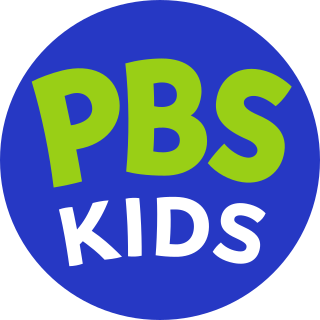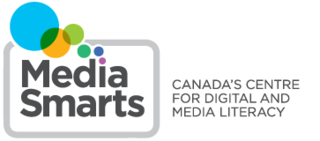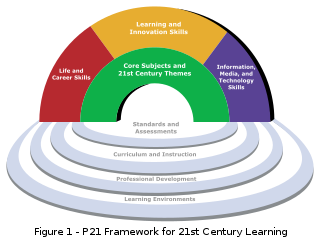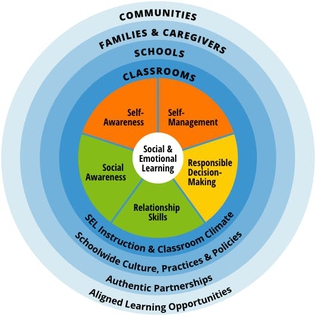Media literacy is an expanded conceptualization of literacy that includes the ability to access and analyze media messages as well as create, reflect and take action, using the power of information and communication to make a difference in the world. Media literacy is not restricted to one medium and is understood as a set of competencies that are essential for work, life, and citizenship. Media literacy education is the process used to advance media literacy competencies, and it is intended to promote awareness of media influence and create an active stance towards both consuming and creating media. Media literacy education is part of the curriculum in the United States and some European Union countries, and an interdisciplinary global community of media scholars and educators engages in knowledge and scholarly and professional journals and national membership associations.

A preschool, also known as nursery school, pre-primary school, play school or creche, is an educational establishment or learning space offering early childhood education to children before they begin compulsory education at primary school. It may be publicly or privately operated, and may be subsidized from public funds.
The International School of Curitiba (ISC), founded in 1959, is located in Curitiba, Paraná, Brazil.

PBS Kids is the brand for most of the children's programming aired by the Public Broadcasting Service (PBS) in the United States. The target audience is children between the ages of 2 and 8. PBS Kids brand programming is aired daily on most local PBS stations during a daytime block, typically scheduled in the morning hours, in addition to a separate 24/7 channel. Both the block and 24/7 service are broadcast over the air, via cable and satellite providers and on streaming platforms. Select programming is also available internationally.

Education in El Salvador is regulated by the country's Ministry of Education. El Salvador consists of the following levels of education:
Family literacy is a method of education. Relatively new, family literacy is being put into practice in the United States, Canada, and South Africa.

Inclusion in education refers to all students being able to access and gain equal opportunities to education and learning. It arose in the context of special education with an individualized education program or 504 plan, and is built on the notion that it is more effective for students with special needs to have the said mixed experience for them to be more successful in social interactions leading to further success in life. The philosophy behind the implementation of the inclusion model does not prioritize, but still provides for the utilization of special classrooms and special schools for the education of students with disabilities. Inclusive education models are brought into force by educational administrators with the intention of moving away from seclusion models of special education to the fullest extent practical, the idea being that it is to the social benefit of general education students and special education students alike, with the more able students serving as peer models and those less able serving as motivation for general education students to learn empathy.

Hispanic Information and Telecommunications Network, Inc. (HITN) is the largest Spanish-language public broadcasting network in the United States. It delivers educational programming to over 44 million homes nationwide, and reaches over 40% of US households.
The National Educational Goals, also known as the Goals 2000Act were set by the U.S. Congress in the 1990s to set goals for standards-based education reform. The intent was for certain criteria to be met by the millennium (2000). Many of these goals were based on the principles of outcomes-based education, and not all of the goals were attained by the year 2000 as intended. Many see this as the predecessor to the No Child Left Behind program, which mandated measurable improvement in student achievement across all groups. Goals 2000 established a framework in which to identify world-class academic standards, to measure student progress, and to provide the support that students may need to help meet the standards.
Susan Neuman is an educator, researcher, and education policy-maker in early childhood and literacy development. In 2013, she became Professor of Early Childhood and Literacy Education, and Chair of the Department of Teaching and Learning at NYU's Steinhardt School of Culture, Education, and Human Development.

The Joan Ganz Cooney Center is an independent, non-profit, non-partisan research and innovation group founded by Sesame Workshop to advance children's literacy skills and foster innovation in children's learning through digital media.

Indigenous education specifically focuses on teaching Indigenous knowledge, models, methods, and content within formal or non-formal educational systems. The growing recognition and use of Indigenous education methods can be a response to the erosion and loss of Indigenous knowledge through the processes of colonialism, globalization, and modernity.
The children's television show Sesame Street, which premiered on public broadcasting television stations in 1969, was the first show of its kind that utilized a detailed and comprehensive educational curriculum, with specific educational goals, in its content. Its goals were garnered from in-house formative research and independent summative evaluations, and its first curriculum was created in a series of five seminars in 1968.

ABCmouse.com Early Learning Academy is a digital education program for children ages 2–8, created by the edtech company Age of Learning, Inc. The program offers educational games, videos, puzzles, printables, and a library of regular and “read-aloud” children’s books, covering subjects including reading and language arts, math, science, health, social studies, music, and art.

MediaSmarts is a Canadian non-profit organization and registered charity based in Ottawa, Ontario, that focuses on digital and media literacy programs and resources. In particular, the organization promotes critical thinking via educational resources and analyzes the content of various types of mass media.
Global citizenship education (GCED) is a form of civic learning that involves students' active participation in projects that address global issues of a social, political, economic, or environmental nature. The two main elements of GCE are 'global consciousness'; the moral or ethical aspect of global issues, and 'global competencies', or skills meant to enable learners to participate in changing and developing the world. The promotion of GCE was a response by governments and NGOs to the emergence of supranational institution, regional economic blocs, and the development of information and communications technologies. These have all resulted in the emergence of a more globally oriented and collaborative approach to education. GCE addresses themes such as peace and human rights, intercultural understanding, citizenship education, respect for diversity and tolerance, and inclusiveness.

21st century skills comprise skills, abilities, and learning dispositions that have been identified as being required for success in 21st century society and workplaces by educators, business leaders, academics, and governmental agencies. This is part of a growing international movement focusing on the skills required for students to master in preparation for success in a rapidly changing, digital society. Many of these skills are also associated with deeper learning, which is based on mastering skills such as analytic reasoning, complex problem solving, and teamwork. These skills differ from traditional academic skills in that they are not primarily content knowledge-based.
Curricula in early childhood care and education (ECCE) or early childhood curriculum address the role and importance of curricula in the education of young children, and is the driving force behind any ECCE programme. It is ‘an integral part of the engine that, together with the energy and motivation of staff, provides the momentum that makes programmes live’. It follows therefore that the quality of a programme is greatly influenced by the quality of its curriculum. In early childhood, these may be programmes for children or parents, including health and nutrition interventions and prenatal programmes, as well as centre-based programmes for children.
Newcomer education is the specialized teaching of refugees, migrants, asylees, and immigrants who have resettled in a host country, with the goal of providing the knowledge and skills necessary to integrate into their country of refuge. Education is the primary way by which newcomers can adjust to the linguistic, social, and cultural environments of their new communities. Newcomer education aims to empower newcomers with a sense of self-efficacy and social integration, as well as giving them the skills to pursue employment or higher education. Newcomer education also aims to help address trauma, culture shock, and other negative effects of forced displacement. Education for newcomers can provide long-term prospects for stability of individuals, communities, countries and global society.

Social–emotional learning (SEL) is an educational method that aims to foster social and emotional skills within school curricula. SEL is also referred to as "socio-emotional learning", "social and emotional learning", or "social–emotional literacy". In common practice, SEL emphasizes social and emotional skills to the same degree as other subjects, such as math, science, and reading. Furthermore, SEL emphasizes an importance upon preparing students to become knowledgeable, responsible, and caring members of society when they reach adulthood.











